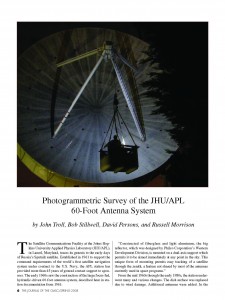
|
Download Members: $0.00 Non‑Members: $75.00 |
Buy Now |
Publication Details
| Published Date: | |
|---|---|
| Authors: | John Troll, Bob Stillwell, David Persons, Russell Morrison |
| Company: | CMSC |
| Print Format: | Technical Paper |
| Citation: | John Troll, Bob Stillwell, David Persons, Russell Morrison, "Photogrammetric Survey of the JHU/APL 60-Ft Antenna System," The Journal of the CMSC, Vol. 3, No. 1, Spring 2008 |
Abstract
The Satellite Communications Facility at the Johns Hopkins University Applied Physics Laboratory (JHU/APL), in Laurel, Maryland, traces its genesis to the early days of Russia’s Sputnik satellite. Established in 1961 to support the command requirements of the world's first satellite navigation system under contract to the U.S. Navy, the APL station has provided more than 45 years of ground contact support to sponsors. The early 1960s saw the construction of the large focus-fed, hydraulic-driven 60-ft antenna system. From the mid-1960s through the early 1980s, the station underwent many and various changes. The dish surface was replaced due to wind damage. Additional antennas were added. In the early 1980s, the control room and the control system for the 60-ft antenna were completely rebuilt. The antenna is currently equipped for S-band and VHF operation. To meet future customer needs, the antenna equipment is to be upgraded to a Cassegrain design that will function at X-band. To function properly at this frequency, the surface profile of the dish must match the nominal shape to within certain root-mean-square tolerances. Thus, to ensure adequate performance in the upgraded system, the dish surface profile required measurement.






